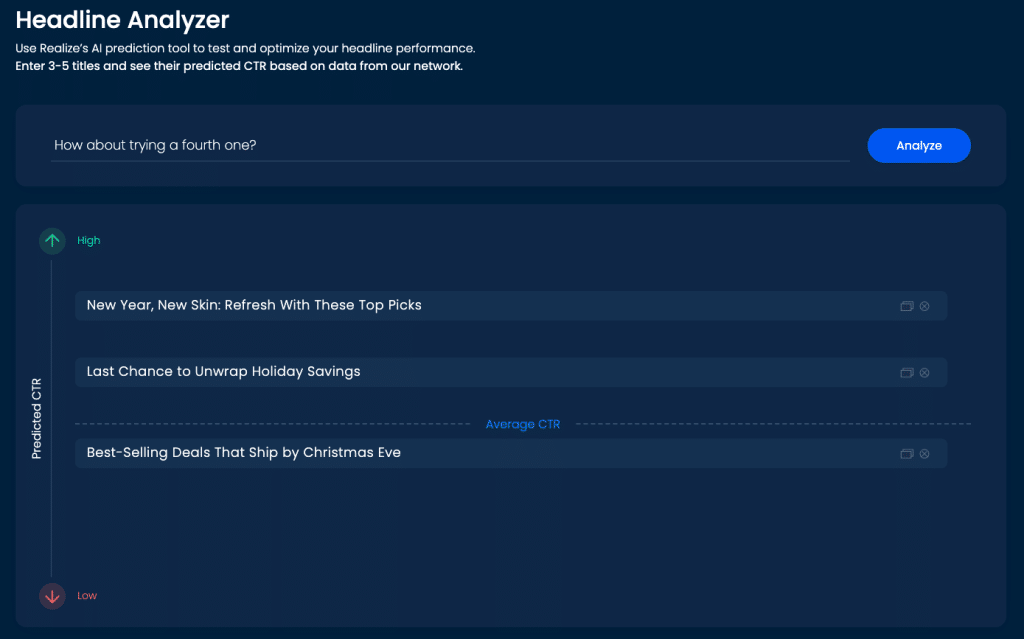In today’s competitive search marketplace, headlines are everything. They don’t just get attention — they win the click, which is exactly what you’re working so hard to achieve.
The holiday season brings even more pressure for content marketers. As sales surge, competition intensifies, leaving you challenged to cut through the noise. Artificial intelligence (AI) can give you that edge you need, whether you’re blogging on your own website or setting up ads and social media posts.
Realize Trends is designed to help you improve your holiday headline game, whether you are optimizing for back-to-school or Cyber 5 week, with built-in insights that show you, in real time, the headlines that are getting results. Here’s how to use those insights to create scroll-stopping, conversion-driving headlines.
Discover What Your Audience is Interested In
Why Should You Care About Headlines?
First impressions are important, and your headline serves as your introduction to a potential customer. Whether it’s a blog title, native ad, or social media post, your headline tells users what to expect — and, more importantly, whether they should engage or keep scrolling.
That said, the holiday season brings a shift in online behaviors. Online shopping can become more frantic as users scramble to buy gifts without going broke. Consumer searches may also be driven by nostalgia for holidays past, giving marketers a valuable opportunity to connect with new audiences.
“The Headline Trends section in Realize identifies weekly-updated performance patterns in top-performing headlines across Taboola’s platform,” says Maayan Leshem, director of creative shop and AI strategies at Taboola. “This lets marketers align their headlines with real-time consumer engagement trends, instead of relying solely on intuition or past-year data.”
4 Tips to Write Engaging Headlines with Realize Trends
Creating effective headlines combines creativity with hard data and timing. This is especially true during the holiday season, when brands have a short timeframe to engage potential customers. Here are some tips that can help you boost engagement during the final weeks of the year.
1. Spot the Trend
The Headline Trends feature makes it easy to view trending topics to inform your content strategy. Because the results are in real time, you can quickly gather information on what’s working during the current holiday season. The key is to find the right verbiage for your industry segment.
“For holiday creatives, marketers can spot trending adjectives, keywords, and verbs tailored to seasonal sentiment — like ‘festive,’ ‘save now,’ and ‘limited edition,’” Leshem says. She adds that headline themes like “urgency,” “self-gifting,” “nostalgia,” and “celebration” pack a solid emotional punch during the holiday season.
2. Use the Right Filters
Headline Trends lets you pull top-performing keywords, phrases, and emotional triggers across multiple channels, but to get those results, you’ll need to choose the right filters. During the holiday season, the most useful filters are:
- Vertical: See what’s working for your category, whether it’s fashion, pets, electronics, or beauty.
- Country and language: Localize your language and references for cultural relevance, which is crucial for holiday-season campaigns.
- Device: Mobile and desktop shoppers tend to engage differently. For instance, mobile users might prefer shorter, action-driven headlines and concise, action-driven copy.
3. Choose the Right Words
Words matter. According to Taboola data, the following words, when used in a headline, can be highly impactful, particularly during the holiday rush:
- Adjectives: Cozy, perfect, limited, exclusive, and best-selling.
- Verbs: Grab, shop, unwrap, gift, save, and treat.
- Keywords: Holiday, deal, last chance, for her/him, stocking stuffer, and free shipping.
“These words evoke emotion, action, and timeliness, all of which are critical in holiday shopping decisions,” Leshem says.
4. Balance Urgency With Authenticity
Urgency incites action, and that’s especially true during the holiday season. Phrases like “Time Is Running Out” and “Last Chance for Christmas Delivery” can increase conversions. Overuse of these terms may undermine your credibility, though, so that’s where balancing it with authenticity can help.
“Balance comes from pairing urgency phrases with authentic emotional or value-based appeals,” Leshem says. “Instead of just, ‘Last Chance!’, try, ‘Last Chance to Gift Joy’ or ‘Ends Tonight: Wrap Up the Perfect Surprise.’”
You can also create urgency using specifics like “Only 200 Left” and “Ships in 24 Hours.” These factual statements are straightforward and simple.
Examples of Effective Headlines (Holiday Edition)
Seeing is believing! These examples of hot headlines, straight from the Realize tool, demonstrate how an eye-catching headline can stop the scroll and encourage clicks.

Cozy Must-Haves to Gift Yourself This Winter
Why it works: Shoppers might be focused on buying for others, but that doesn’t mean they can’t grab a few things for themselves. “Cozy must-haves” paints a comforting picture of soft blankets, fuzzy socks, and warm beverages, while “gift yourself” tags onto the “treat yourself” trend. The message of prioritizing joy while shopping for others can resonate well just after Cyber Week, when the stress of searching for the right gifts leaves customers ready to seek some relaxation.
Last Chance to Unwrap Holiday Savings
Why it works: This headline delivers a one-two punch — both urgency and seasonal relevance. The phrase “last chance” evokes fear of missing out (FOMO), prompting shoppers to take action before the offer is gone. “Unwrap holiday savings” brings that emotional connection, reminding shoppers of the joyful experience of opening presents, especially when those presents come at a cost savings. This headline is perfect for later in the season, when shoppers are rushing to check off those last few gifts on their list.
Best-Selling Deals That Ship by Christmas Eve
Why it works: This headline hits on three fronts. First, there’s the social proof that comes with the term “best-selling.” It showcases items that are popular, serving as a shortcut for last-minute shoppers who simply don’t have time to research. As always, “deals” appeals to the bargain hunter. It’s the phrase “that ship by Christmas Eve” that seals the deal, though. It reassures time-crunched shoppers that their purchase will arrive when it needs to. It’s a great end-of-season marketing push that can earn you extra revenue.
New Year, New Skin: Refresh With These Top Picks
Why it works: Once all the presents are unwrapped, attention turns to another big milestone — the end of the year. Words like “refresh” capture the spirit of the “clean slate” theme that comes with the start of a new year. “New year, new skin” is a clever play on the “new year, new you” phrasing, making it clear what you’re offering. Lastly, the term “top picks” lets customers know that the products have been curated to make things easier for those shopping for new beauty products. This is a great way to extend your holiday sales beyond Christmas.
If you want to make sure your headline hits the mark, it’s well worth trying the Headline Analyzer within Realize Trends. “The analyzer scores your headlines using CTR scores relative to others in your vertical,” Leshem explains. “It also highlights weak spots, such as low-impact words. Users should treat this as a creative tuning tool, making small headline changes to push performance before launching at scale.”
Pairing Visuals and Headlines: A Holiday Must
While a compelling headline gets results, pairing it with an eye-catching visual can amplify its effect. That’s where Image Trends can help. This AI-powered tool reveals the visuals showing the most engagement.
“From past insights, we know that indoor imagery often outperforms outdoor shots during the holidays,” Leshem says. “Warmth, comfort, and authenticity win.”
Top-performing images for the holidays include the following traits:
- Warm indoor settings (e.g., kitchens and fireplaces).
- Bright reds, golds, and greens.
- Hands holding gifts, decorations, or people looking at the camera.
- Real-life photos over polished studio shots.
For best results, Leshem recommends combining Image Trends with headline insights. “Pull top-performing images from Image Trends, then match them with equally strong headline variants from Headline Trends and the Analyzer,” she says.
When to Refresh Creatives
Normally, trends may refresh every month or so, but that isn’t the case during the holiday season. Things move fast, and trends can change from one week to another. “Check Realize Trends weekly for shifts in tone, keywords, and imagery,” Leshem advises. “Refresh creatives every 10-15 days to remain aligned with trend data.”
Leshem finds it best to start monitoring trends early, suggesting that you start in late September or early October for any Black Friday content, then use October to analyze holiday trends and begin early testing. From there, you should revisit trends weekly starting in early November and continuing until the holiday season is complete. “For New Year’s and January deals, shift your tone to ‘refresh,’ ‘declutter,’ and ‘start the year right,’” she adds.
Key Takeaways
During the holiday season, headlines matter more than ever. Tools like Realize Trends offer timely insights into user engagement, helping you adjust your approach to get immediate results. Using emotional triggers and seasonal language like “cozy,” “unwrap,” and “gift,” you can connect with busy, time-sensitive shoppers. You can also combine the Headline Analyzer with Image Trends to fine-tune your creatives before launch.
Frequently Asked Questions (FAQs)
How much time should you spend writing headlines?
More time than you think! While headlines seem like a quick task, they’re the first impression you make on a new customer. In fact, one study found that 75% of those who share an article on social media don’t read beyond the headline before sharing. This can be especially true during the chaotic holiday season, when ad fatigue sets in and audiences are bombarded with promotions. Allocate extra time to test headline variations and optimize based on your results.
How do you start writing a headline?
Every headline starts by capturing the message in its corresponding content. You should also consider the emotion or action you want to inspire. Are you creating urgency in the hopes of getting clicks, or is your goal to build your brand by promoting comfort? Once you have your topic and goal in mind, consult the Headline Trends tool to look for keywords and terms that are currently resonating with readers in your industry and location. Using that information, come up with three to five options and test them using the Headline Analyzer.
What is the format for headlines?
Headline formats tend to vary by vertical and audience, but for SEO purposes, it’s best to keep your headlines to 60 characters or less. For social sharing, posts with shorter headlines (8-12 words) get more shares on X, while longer headlines (12-14 words) get more Facebook likes. Start with a strong verb or an attention-grabbing phrase, then clearly convey value or emotion. Also consider adding a number to your headline when relevant. Headlines like “5 Holiday Must-Haves” can capture attention and get clicks.



